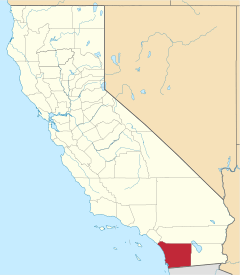San Pasqual Band of Diegueno Mission Indians
The San Pasqual Band of Diegueño Mission Indians of California is a federally recognized tribe of Kumeyaay Indians,[3] who are sometimes known as Mission Indians.
_Sailors_watch_as_San_Pasqual_Tribal_Chairman_Allen_Lawson%2C_welcomes_guests_to_the_media_availability_for_a_Habitat_for_Humanities_project%2C_%5Eldq.jpg) San Pasqual Tribal Chairman Allen Lawson introduces a Habitat for Humanity project on the reservation, 2004 | |
| Total population | |
|---|---|
| 950 enrolled members[1] | |
| Regions with significant populations | |
| Languages | |
| Ipai,[2] English | |
| Religion | |
| Traditional tribal religion, Christianity (Roman Catholic) | |
| Related ethnic groups | |
| other Kumeyaay tribes, Cocopa, Quechan, Paipai, and Kiliwa |
Reservation
The San Pasqual Reservation (33°12′41″N 116°57′40″W) is a federal reservation, located in northeastern San Diego County, California, near Valley Center. It is made up of five, non-contiguous parcels of land that total 1,379.58 acres (5.5830 km2).[4] The original reservation, founded in 1910, is now the San Diego Wild Animal Park and Lake Wolford. Reservation population is approximately 752, and 435 tribal members live in the general area.[3] 21 people of 214 enrolled members lived there in the 1970s.[4]
Government
The San Pasqual Band is headquartered in Valley Center. They are governed by a democratically elected tribal council. Allen E. Lawson is their current tribal chairperson.[5]
Economic development
The tribe owns and operates the Valley View Casino, Black and Blue Steakhouse, The Buffet, BLD's Cafe, Mainstage Bar, Scoops Gelateria, and Sweets Coffee Shop, all located in Valley View. The tribe also maintains and owns the Woods Valley Golf Course as an enterprise of San Pasqual.[6]
Notes
- Pritzker, 147
- Eargle, 118-9
- "California Indians and Their Reservations: S. SDSU Library and Information Access. (retrieved 23 May 2010)
- Shipek, 612
- "Tribal Governments by Area." Archived 2010-05-05 at the Wayback Machine National Congress of American Indians. (retrieved 23 May 2010)
- "Valley View Casino." 500 Nations. (retrieved 23 May 2010)
References
- Eargle, Jr., Dolan H. California Indian Country: The Land and the People. San Francisco: Tree Company Press, 1992. ISBN 0-937401-20-X.
- Pritzker, Barry M. A Native American Encyclopedia: History, Culture, and Peoples. Oxford: Oxford University Press, 2000. ISBN 978-0-19-513877-1.
- Shipek, Florence C. "History of Southern California Mission Indians." Handbook of North American Indians. Volume ed. Heizer, Robert F. Washington, DC: Smithsonian Institution, 1978. 610-618. ISBN 0-87474-187-4.
External links
- San Pasqual Band of Diegueno Mission Indians, official website
